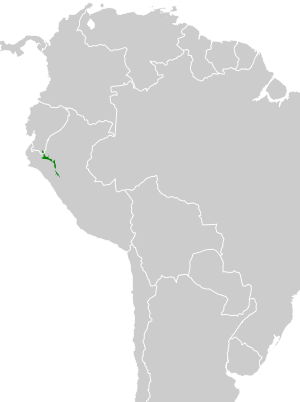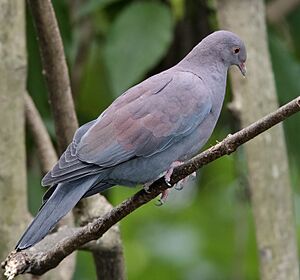Maranon pigeon facts for kids
Quick facts for kids Maranon pigeon |
|
|---|---|
 |
|
| Conservation status | |
| Scientific classification | |
| Genus: |
Patagioenas
|
| Species: |
oenops
|
 |
|
| Synonyms | |
|
Columba oenops Salvin, 1895 |
|
The Maranon pigeon, also known as the Peruvian pigeon or Salvin's pigeon (Patagioenas oenops), is a type of bird. It belongs to the pigeon and dove family, called Columbidae. You can find this special bird living in parts of Ecuador and Peru.
Contents
About the Maranon Pigeon
What's in a Name?
Different groups of bird experts have slightly different names for this pigeon. The International Ornithological Committee (IOC) calls it the Maranon pigeon. Other groups, like the American Ornithological Society and the Clements taxonomy, prefer to call it the Peruvian pigeon.
This pigeon is a unique species, meaning it does not have different subspecies. It is closely related to the red-billed pigeon and the plain pigeon. These three pigeons might even be part of a larger group of very similar species.
Appearance of the Maranon Pigeon
Maranon pigeons are medium-sized birds. Male pigeons are about 34 centimeters (13 inches) long. Females are a bit smaller, measuring 31 to 34 centimeters (12 to 13 inches). They usually weigh around 276 grams (9.7 ounces).
Adult male Maranon pigeons have a dull reddish or reddish-purple color on their head, neck, and chest. Their upper body is blue-gray to dark gray. You might see a purplish-chestnut shade on their middle back and wings. Their belly area is light gray, and their tail is dark gray.
The pigeon's eye is black. It has orange and blue rings around it, surrounded by bare blue-gray skin. Female Maranon pigeons are usually duller and browner than males. Young pigeons also look duller and browner.
Where Maranon Pigeons Live
The Maranon pigeon lives in a specific area. You can find it in the very southeastern part of Ecuador. From there, its home stretches southeast into Peru, reaching as far as the Department of La Libertad.
These pigeons move between different types of forests depending on the season. They live near rivers in what is called riparian forest. They also live in dryer forests higher up on hillsides. You can find them at elevations from 850 meters (2,790 feet) up to 2,400 meters (7,900 feet) above sea level.
Maranon Pigeon Behavior
What Maranon Pigeons Eat
Maranon pigeons usually look for food in small groups. Scientists do not know a lot about their exact diet. However, people have seen them eating ripe seeds from coca plants. They also eat fruits from a plant called Cordia lutea.
Reproduction and Life Cycle
Scientists know very little about how Maranon pigeons reproduce. We do not have much information about their breeding habits or their life cycle.
Maranon Pigeon Sounds
The Maranon pigeon has a special song. It is a rhythmic series of cooing sounds. The song usually starts with one note. Then, it follows with three notes repeated over and over. It sounds like: "rwhoOoh...pUh-hu-whoOOo...pUh-hu-whoOOo...pUh-hu-whoOOo..."
Status of the Maranon Pigeon
The IUCN (International Union for Conservation of Nature) has looked at the Maranon pigeon. They have listed it as "near threatened." This means the pigeon's population is getting smaller.
The main reason for this decline is the loss of its natural home. When forests are cut down or changed, the pigeons lose places to live and find food. This loss of habitat is causing their numbers to drop.
See also
 In Spanish: Paloma peruana para niños
In Spanish: Paloma peruana para niños



